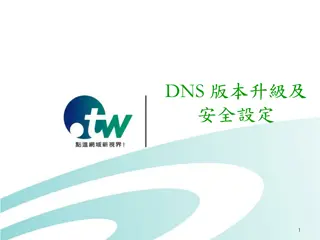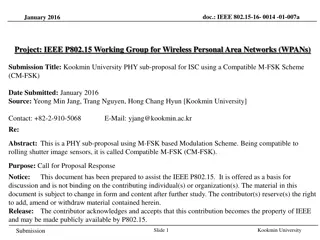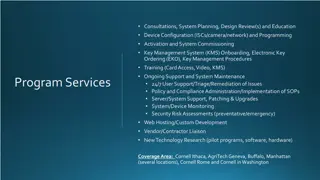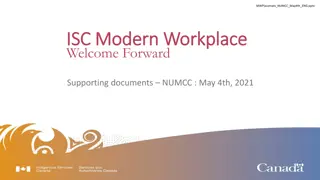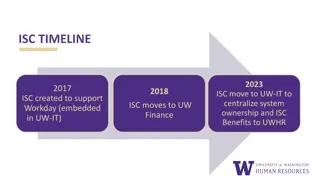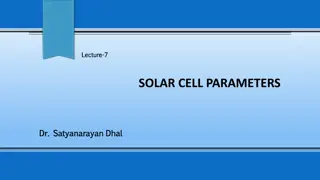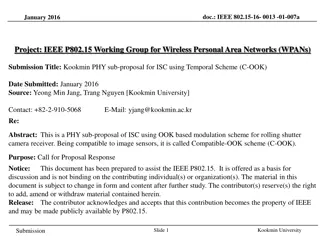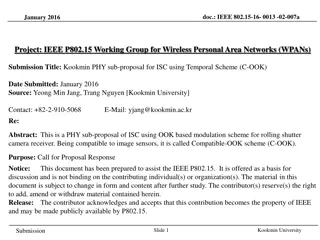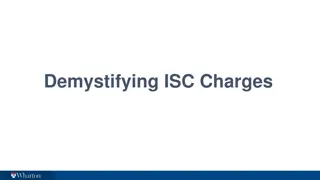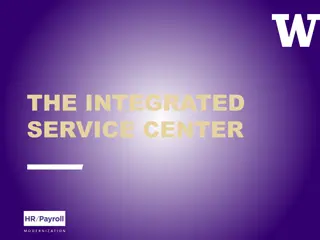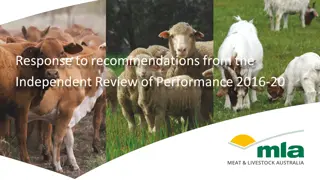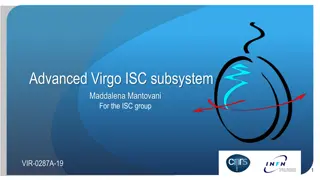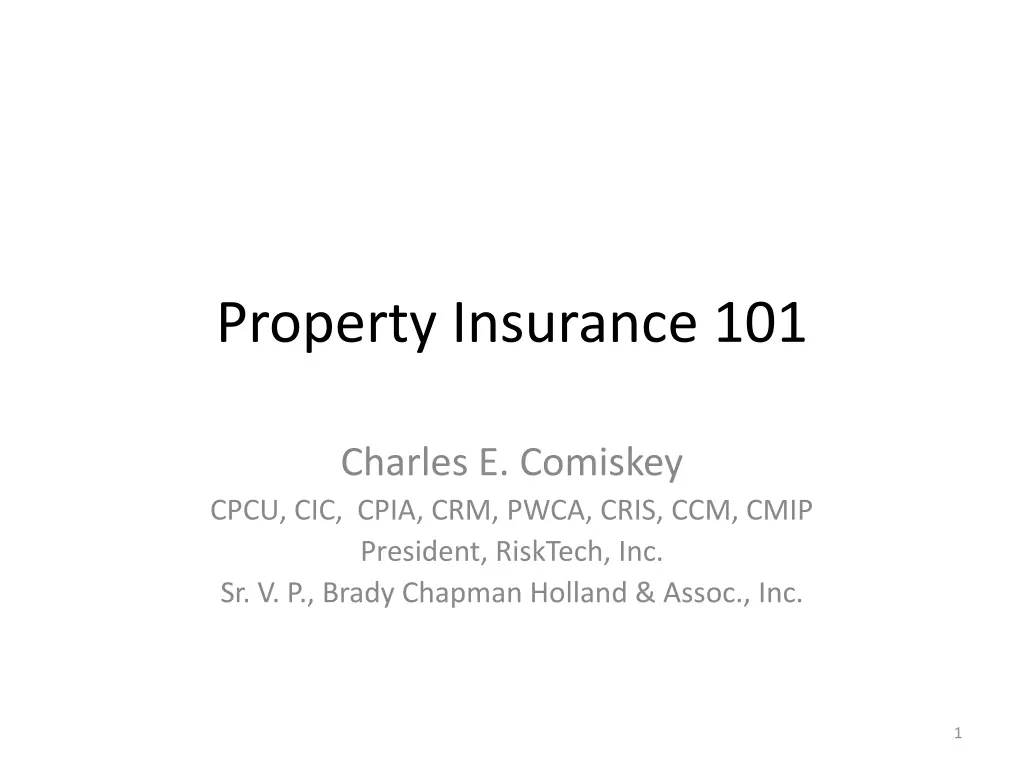
Understanding Building Blocks of Property Insurance
Learn about the fundamentals of property insurance, including the types commonly required, what property insurance is and isn't, and the key aspects of property insurance policies and endorsements. Explore the different causes of loss covered, how coverage is determined, and the importance of insuring tenant improvements and betterments.
Uploaded on | 0 Views
Download Presentation

Please find below an Image/Link to download the presentation.
The content on the website is provided AS IS for your information and personal use only. It may not be sold, licensed, or shared on other websites without obtaining consent from the author. If you encounter any issues during the download, it is possible that the publisher has removed the file from their server.
You are allowed to download the files provided on this website for personal or commercial use, subject to the condition that they are used lawfully. All files are the property of their respective owners.
The content on the website is provided AS IS for your information and personal use only. It may not be sold, licensed, or shared on other websites without obtaining consent from the author.
E N D
Presentation Transcript
Property Insurance 101 Charles E. Comiskey CPCU, CIC, CPIA, CRM, PWCA, CRIS, CCM, CMIP President, RiskTech, Inc. Sr. V. P., Brady Chapman Holland & Assoc., Inc. 1
Types of Property Insurance Commonly Required Real Estate Building Business Personal Property (not just contents) Leasehold Improvements HVAC & related equipment Business Income (f/k/a Business Interruption)/Loss of Rents Equipment Breakdown (a/k/a Boiler & Machinery) Construction Inland Marine Builder s Risk Installation Floater Equipment Floater 2
What Property Insurance Is/Isnt Property insurance is first party coverage that reimburses the insured for its own property loss. Property insurance is not: Casualty insurance A casualty may trigger property insurance or liability insurance, but casualty insurance means only liability insurance Fire Insurance Extended Coverage Vandalism and Malicious Mischief Special Extended Coverage All Risk or All Risk 3
Building Blocks of Property Insurance Insurance Services Office ( ISO ) promulgates insurance policy and endorsement forms that are used by insurers nationally. The type of coverage being discussed is shown by the letters. The first four numbers are the form number prescribing the content. The last four numbers are the edition date of the form. Beware: Edition changes bring forth coverage changes. The Basic Forms: Property Covered CP 00 10 10 12 Business Income and Extra Expense/Rental Value CP 00 30 10 12 Covered Causes of Loss Equipment Breakdown 4
Building Blocks of Property Insurance Property insurance does not refer to covered perils . Instead, it refers to causes of loss . Basic Causes of Loss CP 10 10 10 12 covers only specifically named causes Broad Causes of Loss CP 10 20 10 12 covers only specifically named causes Special Causes of Loss CP 10 30 10 12 covers direct physical loss unless otherwise excluded Transfers burden of proof Add Flood and/or Earthquake Add Equipment Breakdown (sudden and accidental mechanical or electrical) HVAC Electrical switchgear Elevators 5
Insuring Tenant Improvements and Betterments Building and Personal Property Coverage Form CP 00 10 10 12 covers: (6) [a Named Insured s] use interest as tenant in improvements and betterments. Improvements and betterments are fixtures, alterations, installations, or additions: (a) Made a part of the building or structure you occupy but do not own; and (b) You acquired or made at your expense but cannot legally remove. 6
Insuring Tenant Improvements and Betterments New property endorsements from ISO. Leases often require commercial tenants to insure or be responsible for certain building property, such as HVAC equipment, building fixtures, permanently installed machinery equipment and building glass. Scheduled Building Property Tenant s Policy CP 14 01 09 17 modifies the tenant s policy to allow them to include certain landlord-owned building property as insured property, provided the property is specifically scheduled. Unscheduled Building Property Tenant s Policy CP 14 02 09 17 modifies the tenant s policy to allow them to include certain landlord-owned building property as insured property, but unlike the CP 14 01, does not require the insured to specifically scheduled the property. Both endorsements define building property to mean building fixtures and permanently installed machinery and equipment. The only difference is that the CP 14 01 includes building glass in the definition of building property and the CP 145 021 requires a separate limit for building glass. 7
Insuring Tenant Improvements and Betterments Optional Ordinance or Law Coverage Coverage has been limited to only building codes that are in effect at the time of the loss. New building codes adopted after the loss but before rebuilding or reconstruction begins have not been covered, yet could result in increased building costs for the insured. Now available is the option to obtain protection for the possibility of new building codes. This option is available in the 09 17 editions of the Ordinance or Law CP 04 05, Ordinance or Law-Increased Period of Restoration CP 15 31 and Functional Building Valuation CP 04 38 endorsements. Ordinance or Law Coverage for Tenant s Interest in Improvements and Betterments (Tenant s Policy) CP 04 26 09 17 Tenants often makes changes to the buildings they occupy (a/k/a tenant improvements and betterments). Although the tenant acquires and installs these additions, they cannot be removed because they legally become part of the real property, which is owned by the landlord. Even though real property improvements and betterments are part of the building, landlords generally require tenants to be responsible for insuring them, creating a coverage gap. 8
Valuation Methods Actual Cash Value (ACV) Replacement cost less physical (not book) depreciation Replacement Cost at time of loss, like kind & quality, at the same location Reconstruction cost, not tax value or sale value Proceeds, once determined in this manner, can be used to reconstruct at a different location Includes cost of demolition, generally estimated at 13% of the value of the improvements Only ACV will be paid unless/until the property is restored Ordinance or Law so long as arising from a covered cause of loss, covers: Loss to the undamaged portion of the building; Cost to demolish the undamaged portion of the building; and The increased cost of construction to comply with current ordinances. Agreed Value suspends operation of the coinsurance clause, eliminating potential penalty Blanket provides coverage on multiple buildings or business personal property at multiple locations subject to a cumulative total amount of coverage Margin Clause limits recovery to a stated percentage of insured value per location 9
Coinsurance Coinsurance is a warranty to the insurance company that the amount of insurance purchased is equal to at least a stated percentage of the insured value Minimum of 80% for single insured location 90% or 100% for multiple locations covered by cumulative limit ( blanket insurance) Property insurance rate decreases as coinsurance % increases 10
Coinsurance Single Building Property Value: $5,000,000 Policy Limit: $3,000,000 Coinsurance Percentage: 80% Loss Incurred: $500,000 Formula: Did/should = $3M/$4M (80% of $5M) X Loss Recovery: $375,000 less deductible Recovery if Agreed Value added: $500,000 less deductible 11
Blanket Property Insurance Property Values: Three buildings valued at $2,000,000, $3,000,000 and $5,000,000 Policy Limit: $9,000,000 Coinsurance Percentage: 90%, subject to Agreed Value Loss Incurred: $3M building is destroyed & replacement cost turns out to be $4,250,000 Recovery of $4,250,000 12
Beware of Margin Clause Limits recovery to no more that a stated % of the scheduled value of each insured property Ranges from 1.05% to 1.30% Wipes out Agreed Value and Blanket advantages Same exact example but now add a 1.10% margin clause Recovery now only $3,300,000 Insured paid same premium but now loses $950,000 recovery 13
Business Income Business income is: We will pay for the actual loss of business income you sustain due to the necessary suspension of your operations during the period or restoration. The suspension must be caused by direct physical loss of or damage to property at premises which are described in the declaration and for which a business income limit of insurance is shown in the declarations. The loss or damage must be caused by or result from a covered cause of loss. Net income (net profit or loss before income taxes) that would have been earned or incurred; and Continuing normal operating expenses incurred, including payroll. 14
Rental Value Coverage can be: Business Income Including Rental Value Business Income Other Than Rental Value Rental Value Rental Value means Business Income that consists of: Net Income (Net Profit or Loss before income taxes that would have been earned or incurred as rental income from tenant occupancy of the premises; and Continuing normal operating expenses incurred in connection with that premises. 15
Extra Expense Extra Expense ( EE ) is: Necessary expenses you incur during the period of restoration that you would not have incurred if there had been no direct physical loss. EE to avoid or minimize the suspension of business and to continue operations at the insured premises or at replacement premises or temporary location. EE expense incurred to minimize suspension of business if operation cannot be continued. The hiring of additional workers or paying existing employees overtime in order to reopen the business is covered. Coverage is also provided for EE necessary to repair or replace property but only to the extent the amount of loss otherwise payable is reduced. 16
Key Coverage Triggers The insured suffers a suspension of operations ; The suspension must result from direct physical loss to property at the insured premises; The direct physical damage must be caused by a covered cause of loss; and Income is lost during the period of restoration (only). 17
Important Terms and Concepts Suspension : ISO defines this to mean a slowdown or cessation of the insured business operations (since 2000) Operations : Business activities Period of Restoration : Unendorsed ISO forms define this as the period beginning 72 hours after the direct physical loss and ending when the property should be repaired or replaced. Direct Physical Loss: Property (real or personal) at the described premises was actually damaged. Covered Cause of Loss: Direct physical loss is caused by an event or act specifically listed in or not excluded from the insured s policy. 18
Abatement If the lease provides that the rent abates, then the landlord has a claim for the rental loss under its Loss of Rental Value coverage. If the lease provides that the rent does not abate, then (1) there is no recovery under the landlord s Loss of Rental Value coverage but (2) the Tenant will remain obligated to pay the rent, and (3) this continuing rent payment obligation will be a continuing normal operating expense under the Tenant s Loss of Business Income coverage. Beware: Tenant s rent shall not be abated if the loss is caused by Tenant s negligence Causes Landlord to lose its Loss of Rental Value coverage, leaving Landlord with only a breach of contract claim against Tenant in case of non-payment. 19
Maintenance & Repair Maintenance and Repair does not: Necessarily include replacement of damaged equipment Mean that tenant is required to insure the equipment Equipment of this nature (e.g., HVAC) is subject to causes of loss not covered by building insurance Require tenant to carry equipment breakdown insurance to include all equipment dedicated to the lease space. 20
Vacancy Property is vacant unless at least 31% of total s.f. is: Rented to lessee and used by lessee to conduct operations; or Used by building owner to conduct operations Beware of new construction or properties undergoing renovation. If vacant more than 60 days, some coverages are voided and others reduced by 15%. 21
Leasehold Interest Endorsement CP 00 60 06 95 If the lease is terminated by reason of damage to the property caused by a covered cause of loss, the insurer will pay: The net leasehold interest: the present value of the rental value of the space and the rent that the tenant is actually paying; The unamortized portion of the tenant s improvements and betterments that will be lost; and The prepaid rent. This coverage is of value if the lease is on rental terms that are favorable to the tenant, the tenant has made substantial improvements to the property, or the tenant has prepaid a substantial amount of the rent. 22
Builders Risk Issues that should be considered include: Who is to be insured? To what degree? Amount as increased by subsequent modification of the contract sum. Form at least as broad as unmodified ISO Special Causes of Loss form, and to include theft, flood, earthquake and collapse Covered Property on site, at other locations and in transit Prohibited use of Protective Safeguard Warranty Required Endorsements Deductibles When Coverage Ceases Waivers Notice of Cancellation Delayed Completion and Soft Costs 23
Flood National Flood Insurance Program Commercial Insurance Max available is $500k on building and $500k on contents Applies to specifically insured building only no outbuildings, fences, walls, gate openers, etc. Buildings must have 4 walls and a roof ACV only on both buildings and contents No business income coverage No loss of rents coverage Personal Insurance Max available is $250k on building and $100k on contents Replacement cost on structure only if primary home and maximum limits are carried ACV on secondaries, rental properties, and contents No additional living expense No detached structures covered, except 10% of limit can be applied to detached garage. Condominiums Replacement cost coverage is available on the buildings Unit owners may buy contents coverage which is on an ACV basis 24
Flood Business Income or Loss of Rents No coverage is provided for flood conditions under a property policy unless flood was a covered cause of loss. Even if flood was a covered cause of loss, no coverage is provided due to the ability to access facilities. Coverage must be triggered by covered damage to property at the insured premises. 25
Flood Difference in Conditions Excess Coverage Frequently requires that maximum coverage available from NFIP be provided as underlying coverage May exclude certain flood zones May be pure excess (follow form of underlying coverage) May drop down to provide difference between ACV and Replacement Cost May provide business income or loss of rents coverage 26
Flood Insurance Other Sources Flood coverage may also be included in: Equipment Breakdown (a/k/a Boiler & Machinery) Inland Marine Builder s Risk Equipment Floaters Rental Reimbursement on Equipment Floaters Installation Floaters Valuable Articles Floaters Flood is sometimes provided as part of the property insurance For Property, Builder s Risk, and Installation Floaters, the availability of coverage is commonly restricted to locations outside of the 100 year flood plain. Property insurers may require that the maximum amount of flood coverage available from the NFIP be carried as underlying coverage. 27
Flood Deductibles Within NFIP, the deductible applies separately to each building and its contents. Many policies require that the maximum amount of coverage available from the NFIP be carried as underlying coverage, or a $500,000 deductible. Beware: Some carriers have recently taken the stance that flooding arising from a Named Storm makes the claim subject to the Named Storm deductible. 28
Green Coverage Green Organizations Leadership in Energy and Environmental Design (LEED) ENERGY STAR Green Globes New insurance coverage for increased cost of repairing/replacing materials and products recognized as green. Green products must provide enhanced energy efficient or use of environmentally-preferable, sustainable materials, products, or methods in design, construction, manufacture, or operation. 29
Green Coverage Coverage for Increased Cost of Loss and Related Expenses for Green Updates ISO CP 04 02 10 12 Provides Coverage of Four Related Expenses Waste Reduction and Recycling Design and Engineering Professional Fees Certificate Fees and Related Equipment Testing Building Air-Out and Related Air Testing Non-ISO forms potentially offer additional coverages 30
Terrorism The Terrorism Risk Insurance Program Reauthorization Act ( TRIA ) was extended in 2015. The Federal terrorism coverage legislation now expires on December 31, 2020. Insurers must quote a premium for terrorism coverage when they quote the premium for property coverage but federal terrorism coverage is limited: Only acts certified as acts of terrorism by the Secretary of the Treasury after consultation with the Secretary of Homeland Security and the U.S. Attorney General trigger payment; and Then only if the aggregate losses exceed $5,000.000. Broader terrorism coverage may be available for less premium for larger projects on a stand-alone basis. 31
Risks of Relying on Tenant to Insure the Landlord s Property If Landlord must permit the Tenant to insure the Landlord s property, the Lease should require the Tenant to: Maintain a Special Form policy as well as flood insurance other insurance that is important in the area covering all building and other improvements; Insure the property for its full Replacement Cost; Require Agreed Value or no-coinsurance; Maintain low deductibles; and Include Loss of Rental Value cover for a specified period (at least twelve months). 32
Risks of Relying on Tenant to Insure the Landlord s Property How is Landlord to be added to this coverage? Loss payable provision: Gives an insured little protection Claims must be paid jointly No protection is provided to owner against the policy being invalidated by actions of the tenant/insured No notice of cancellation will be provided to owner This form is really geared to miscellaneous machinery & equipment Lender s loss payable clause: Quite similar to the mortgageholder provision Can be used for buildings, machinery or equipment Protection is provided to the owner for the policy being invalidated by actions of the tenant/insured Notice of cancellation and nonrenewal is provided Fails to discuss handling of claim payment 33
Risks of Relying on Tenant to Insure the Landlord s Property Building owner loss payable clause: Building claim will be adjusted with building owner only and an improvements & betterments claim will be adjusted with tenant No protection is provided to the owner against invalidation of the policy by actions of the tenant/insured No notice of cancellation will be provided to the owner Additional insured-building owner: Makes the building owner a named insured for the building only Loss is adjusted with both the tenant and building owner ATIMA No protection is provided against invalidation of the policy by actions of the tenant/insured No notice of cancellation will be provided to the owner 34
Risks of Relying on Tenant to Insure the Landlord s Property None accomplish the desired combined results of: protection against invalidation of coverage by the Tenant; notice of cancellation to the Owner; and adjustment of building loss with the Owner. A combination of lender s loss payable and additional insured-building owner is the best insurance option if tenant is to insure the building 35
What Is The Best Risk Management Option? Have the owner insure the building and charge the cost back to the tenant. Owner: controls the insurance placement; meets its lender obligations; doesn t have to worry about the tenant violating any policy conditions; receives notice of cancellation; is directly negotiating any claim adjustment; and controls issues regarding the damage and destruction provisions in the lease agreement. 36
Self-Insured Retention Insurance carrier obligation not triggered until retention is met Self-insured = NOT insured Insurance requirements therefore do not apply 37
Self-Insured Retention Recommended: If Tenant elects to self-insure or to maintain insurance required herein subject to deductibles and/or retentions exceeding $25,000.00, Landlord and Tenant shall maintain all rights and obligations between themselves as if Tenant maintained the insurance with a commercial insurer including any Additional Insured status, Primary and Non-Contributory Liability, Waivers of Rights of Recovery, Other Insurance Clauses, and any other extensions of coverage required herein. Tenant shall pay from its assets the costs, expenses, damages, claims, losses and liabilities, including attorney s fees and necessary litigation expenses at least to the extent that an insurance company would have been obligated to pay those amounts if Tenant had maintained the insurance pursuant to this Exhibit. All deductibles, retentions, and/or uninsured amounts shall be paid by, assumed by, for the account of, and at Tenant s sole risk. Landlord shall not be responsible for payment of any deductible or self-insured retention or uninsured amount. 38
Waiver of Subrogation Waiver of Subrogation Subrogation is process where insurance company assumes rights of the insured to gain recovery. It applies only to insured losses. It offers no protection against right of recovery by an insured. Really a two-step process Other party should be required to waive its right of recovery; and Obtain a waiver of subrogation from carrier. Both should be required on all coverage, not just property-related 39
Notice of Cancellation, Nonrenewal, Reduction in Limits, Change, Etc. Notice of Cancellation applies only when the insurer cancels, not when the insured does. Term of Notice of Cancellation is commonly 30 days unless the policy is being cancelled for non-payment of premium, in which case it is ten days. Notice of Cancellation is difficult to obtain from some insurance companies, making it necessary to place a notice requirement on the downstream party. Notice of Material Change is sometimes available. Notice of Non-Renewal is rarely available. There is no such thing as Notice of Reduction in Limits. Don t make up things on which you desire notice. 40
Certificates of Insurance It is a tale, told by an idiot, full of sound and fury, signifying nothing. - Macbeth 41
Certificate Specifications ACORD 25, Certificate of Liability Insurance ACORD 28, Evidence of Commercial Property Insurance Both are replete with disclaimers and are generally held to be unenforceable against the insurance companies designed on the certificates. Detailed certificate requirements should be included in any contract, the intent being to get the other side s insurance agent to state what coverage is not being provided. Better to make this determination in negotiation as opposed to litigation. 42
Questions? Charles E. Comiskey CPCU, CIC, CPIA, CRM, PWCA, CRIS, CCM, CMIP 713.979.9706 (o) 713.254.1818 (c) charles.comiskey@bch-insurance.com www.linkedin.com/in/charlescomiskey 43
Charles E. Comiskey CPCU, CIC, CPIA, CRM, PWCA, CRIS, CCM, CMIP Charles E. Comiskey is President of RiskTech, Inc., Houston s oldest risk management consulting firm, and Senior Vice President of Brady Chapman Holland & Associates, one of the largest privately held insurance brokerage firms in the U.S. Holding a variety of professional designations, Comiskey is a nationally recognized expert, author and frequent speaker on risk management and insurance issues to various legal, construction and real estate associations and similar groups across the country. He has served as a pre-trial consultant/expert witness in over 250 matters in State and Federal courts, serving for both defense and plaintiff testifying for and against insurance companies, insurance agencies, insureds and claimants. Charles is also National Chairman of the Construction Practice Group of RiskProNet International, the 5th largest brokerage organization in the U.S. and a contributing author to the 2017 AIA insurance requirements. 44



